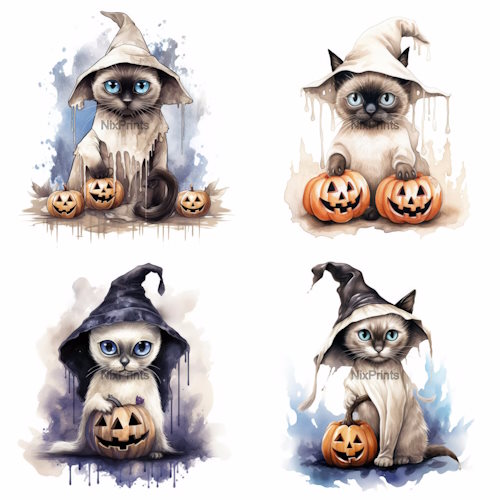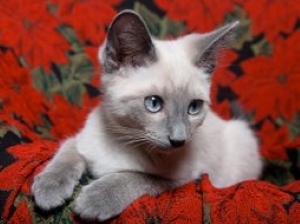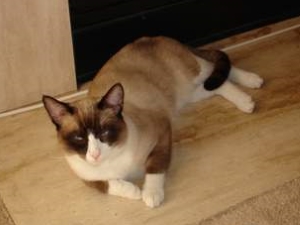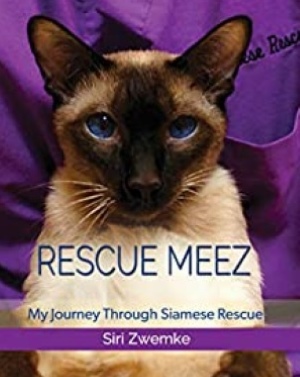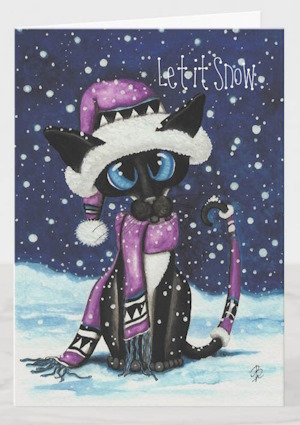- Home
- Meezer Musings
- October 2023
Meezer Musings: October 2023
Shivering and Shaking
Halloween is upon us, the leaves are falling, the days are getting shorter and tricks, treats, witches and pumpkins are in plentiful supply. After a couple of months' break in which I've been caring for my husband after surgery, Meezer Musings is back, just in time for my favorite season of the year.
The end of October marks a shift for most
of us, with thoughts turning
to winter
and nesting and staying cozy indoors - and some of you, I
know, already have snow. As an opener, I thought the sweatshirt below was particularly appropriate this month.
Readers in the southern
hemisphere are more likely to be looking out summer
clothes and firing up barbecues, but here in the UK the clocks have just turned back to winter hours (happening next weekend in the USA
and Canada) and cold weather beckons.
Our opening headline, Shivering and Shaking, is intended to be both a humorous nod to the ghostly ghoulish goings-on of the season and, more seriously and certainly no laughing matter, an opener to this month's main topic in which we're discussing two feline health conditions thought to affect Siamese cats a little more often than other breeds. These are:
- Feline hyperesthesia - a chronic, troubling, 'shivering' of the skin - and
- Nystagmus - a condition in which the eyes are seen to shake.
Before that though I'd like to tell you about a new and unusual children's picture book, which comes with musical accompaniment! Author and musician Lindsay Donat contacted me to ask if I would share the details and I'm very happy to do so, as the book is based on the adventures of Lindsay's own duo of Siamese mix cats.
Moments Musicaux with Marchena and Momo
Moments Musicaux with Marchena and Momo is a heartwarming tale set in rhyme, with whimsical illustrations by Hoda Mir and engaging compositions recorded by author Lindsay Donat, together with fellow Juilliard graduate Raphael Zimmerman.
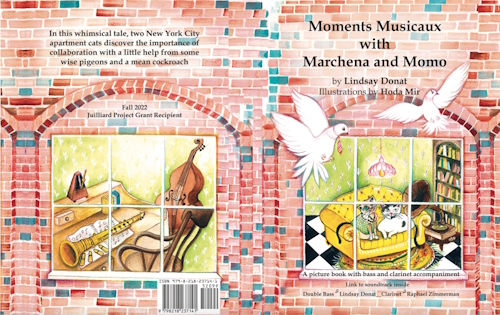 Cover photo with thanks to and copyright © Lindsay Donat
Cover photo with thanks to and copyright © Lindsay DonatThe story takes place in the Upper West Side of New York City and follows two cats with very different personalities and talents. Marchena is a silly, rambunctious cat who loves to show off his ability to jump up high in the air. Momo is posh, cool and collected - and a little jealous of Marchena's talent.
The cats learn the importance of collaboration and teamwork (with a little help from a pair of wise pigeons) when facing off one mean flying cockroach.
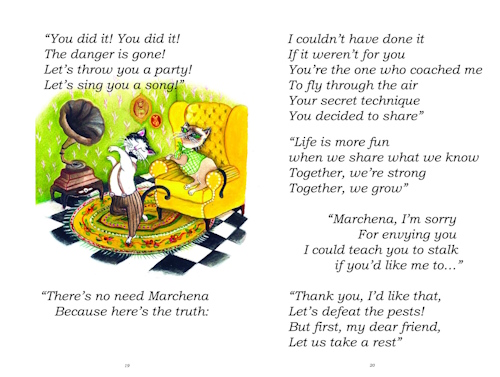 Interior photo with thanks to and copyright © Lindsay Donat
Interior photo with thanks to and copyright © Lindsay DonatThe recordings and sheet music are available for free - a link inside the book leads to recordings of original compositions performed by Raphael Zimmerman on clarinet and Lindsay Donat on double bass.
The book can be purchased through several retailers including Amazon, and you can find out more at www.marchenaandmomo.com. Great fun!
Moving to more serious matters, I'm writing about the topics below as I know several of our readers have cats with nystagmus, and recently a visitor to our Facebook page mentioned that her cat has hyperesthesia.
The conditions are not related, but both affect the nervous system.
What Is Hyperesthesia? Rolling Skin Syndrome
Feline hyperesthesia is an unusual condition characterized by skin twitching, tail swishing, and excessive grooming. It's often referred to as 'rolling skin' or 'twitch-skin' syndrome and it can affect cats of all breeds, although it seems (anecdotally, at least) to be more prevalent in Siamese and Oriental cats and their relatives. However, it hasn't yet been definitively linked to genetics or breed predisposition.
Some of the most common signs of the condition include skin rippling, particularly along the spine; violent tail twitching; excessive grooming to the point of hair loss and self-mutilation; sensitivity to touch, especially along the back and tail; and general agitation, anxiety and restlessness.
The video below (an old one from 2009 - this cat has now passed away from causes unrelated to hyperesthesia) gives you a good idea of the kind of behavior to watch for.
What Causes Hyperesthesia?
The causes of hyperesthesia aren't well understood but it's thought that contributing factors may include allergies and skin irritation; stress and anxiety triggered by changes in a cat's environment, routine or social structure; sensory overload and/or nervous system dysfunction - possibly involving overactive nerve receptors.
As with anything out of the ordinary, if you think your cat may have hyperesthesia it's essential to get a vet to check for any underlying issues and make a proper diagnosis, as well as to provide you with a clear treatment plan.
Treatments for Hyperesthesia
Potential treatments include:
- Stress reduction: A quiet and predictable routine, together with Feliway diffusers which release calming pheromones, may help to alleviate symptoms
- Medications: Your vet may prescribe anti-anxiety drugs, pain relievers, or anticonvulsants to help control nervous system overactivity
- Topical treatments: If skin irritation or allergies are suspected, topical treatments like medicated shampoos or anti-itch creams may be recommended
- Behavioral therapy: Working with a veterinary behaviorist or a certified cat behavior consultant can help address anxiety and behavioral issues
- Environmental enrichment: Providing mental and physical stimulation through toys, puzzles, and interactive play can help distract cats from their symptoms and reduce anxiety
- Dietary modifications: Some cats with hyperesthesia may benefit from dietary changes, such as switching to a hypoallergenic or limited-ingredient diet to address potential food allergies.
What Is Nystagmus? Dancing Eyes
From shivering of the skin we move on to shaking of the eyes. I've mentioned nystagmus before, in a 2021 newsletter on general eye health, but there's more detail below.
Nystagmus is a condition often referred to as 'dancing eyes' as it's an involuntary, rhythmic movement - either a repetitive back-and-forth motion, or a circular rotation of the eyeballs.
Nystagmus is particularly associated with this distinctive eye movement but it can present with accompanying signs including abnormal eye position; loss of balance; abnormal head tilting; vomiting and nausea (the condition can cause motion sickness); and dizziness and disorientation leading to confusion and stress.
This video illustrates the condition well but before watching it turn your sound down, as there's a jolting blast of music just as you get to the end...
What Causes Nystagmus?
Nystagmus can have a variety of underlying causes but the most common of these is vestibular disease - a disorder of the inner ear which plays an important role in balance and spatial awareness.
Other triggers may include infections of the ear or those affecting the nervous system; exposure to toxins or poisons; brain abnormalities such as tumors or inflammation; congenital factors present from birth; or age-related issues, when older cats develop the condition as part of the aging process.
Treatments for Nystagmus
Any treatment for nystagmus will depend on the underlying cause of the condition, but may include:
- Addressing the underlying cause: If the nystagmus is due to an infection, toxin exposure, or an underlying medical condition, treatment may involve antibiotics, supportive care, or surgery to remove tumors
- Medications: Anti-nausea drugs can reduce vomiting and other medications can help with dizziness and balance
- Dietary changes: In some cases a special diet or nutritional supplements may be useful
- Physical therapy: Physical therapy exercises and rehabilitation techniques may help to improve balance
- Eye protection: To prevent injury to the eyes caused by constant movement, protective measures like eye lubricants may be recommended
- Supportive care: Cats with nystagmus need extra attention and care to ensure their safety and comfort - soft bedding and minimizing environmental stressors can be helpful.
As with hyperesthesia, if you suspect that your cat has nystagmus, it's important to get a vet's check-up and formal diagnosis. A treatment plan can then be drawn up to help your cat feel safer and more comfortable.
Tail End ...
I hope this has been useful. That's all from me for this month, but I'll be back at the end of November and before that, you might enjoy a look at what our Siamese Cats at Halloween are up to!
If you're going to be out trick-or-treating with the kids, stay safe out there, or alternatively, enjoy snuggling down with your cats as we (and they) make preparations for the winter.
Before I go ...
I've written before about the origins of Halloween, when the boundary between this world and the next is thought to become thinner and more permeable, allowing the souls of the dead to pass through and visit their old homes in search of hospitality. In a foreshadowing of today's trick-or-treating, offerings of food and drink were traditionally left outside for these unearthly visitors.
I know there are some of you who have lost much-loved cats recently; the loss is always devastating. My thoughts go out to everyone who has had to say goodbye to loved ones, whether human or fur-family.
At this time of remembrance for the departed, remember to take extra care of yourselves and light a candle for those you have lost.
Caroline
Missed a Meezer Musings? A list of previous newsletters can be found here.
Some of the articles and newsletters on this site may contain links to products I think you may enjoy. If
you purchase through these links I receive a small commission, but there's
no extra cost to you. Find out more on the Affiliates Disclosure page.
Have You Discovered Our Newsletter?
If not, why not? Subscribe to our email newsletter, Meezer Musings, to stay in touch, be the first to see new information and pages as they come out, and read the things we only talk about in the newsletter.
Learn more about it on our Newsletter Sign-Up page.

